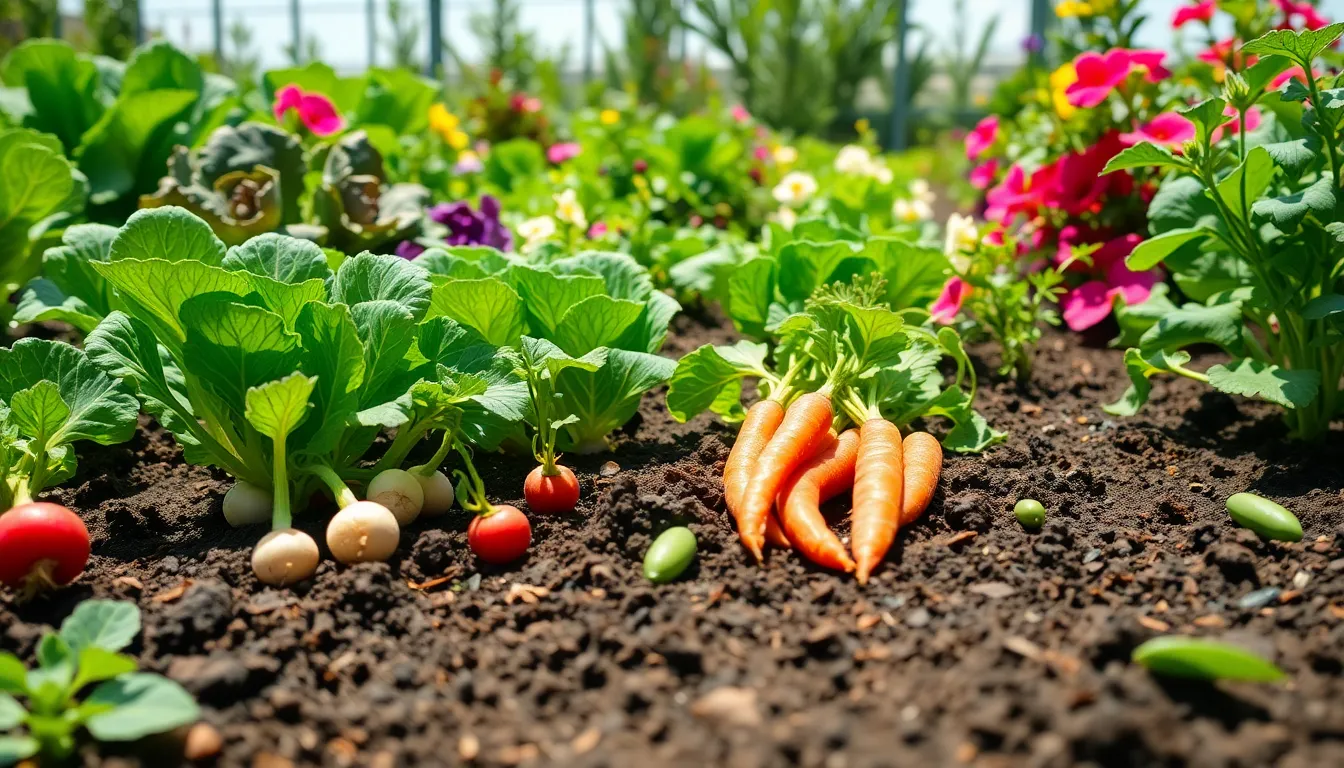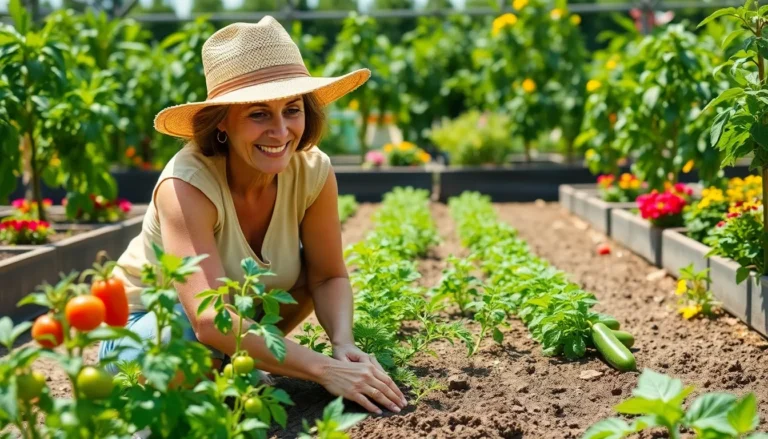Growing your own vegetables might sound like a daunting task, but it doesn’t have to be! Imagine stepping into your backyard and plucking fresh veggies for dinner without breaking a sweat. Some veggies practically beg to be grown, and they’ll reward you with delicious harvests that’ll make your neighbors green with envy.
Easiest Veggies to Grow
Growing vegetables at home offers simplicity and enjoyment, especially with the right choices. Some veggies thrive in various conditions, making them suitable for beginners. Lettuce, for instance, adapts well to different climates and grows quickly.
Radishes stand out for their fast germination; they often sprout within days. Carrots, while requiring patience, can flourish with minimal effort. They prefer loose, well-drained soil and provide flavorful roots.
Tomatoes also rank high for ease; they flourish in warm conditions and yield abundant fruit. Both cherry and heirloom varieties have demonstrated resilience, fitting well into small gardens and containers.
Beans emerge as another simple choice, known for their nitrogen-fixing abilities and quick harvest time. They often require little maintenance and add valuable nutrients to the soil.
Peppers can suit various garden types, thriving in sunny spots while offering colorful additions. Consider planting sweet or hot varieties for diverse flavors and culinary uses.
These vegetables provide accessible options for anyone considering home gardening. Suitable for small plots or larger gardens, these easy-to-grow vegetables promise satisfaction and bountiful yields.
Top Easiest Veggies for Beginners

Growing vegetables can be simple and enjoyable. Beginners can thrive with the right choices.
Lettuce
Lettuce is one of the easiest vegetables to grow. Seeds germinate quickly, typically within 7 to 14 days. It thrives in various conditions, adapting well to sunny or partially shaded spots. Regular watering keeps the soil moist, promoting healthy growth. Leafy varieties, like romaine and butterhead, yield multiple harvests throughout the season. Growing lettuce requires minimal space, making it ideal for small gardens or container planting.
Radishes
Radishes offer swift satisfaction for new gardeners. They germinate within 5 to 10 days, providing an early harvest. These root vegetables prefer cooler weather, growing well in the spring or fall. Minimal care is necessary, with good drainage being crucial. Harvest radishes when they reach the desired size, often in about three to four weeks. Variety availability, including red and black radishes, presents options for flavor and texture.
Carrots
Carrots may require patience, but they are worth the effort. They thrive in loose, well-drained soil, encouraging healthy root growth. Seeds typically germinate in 10 to 20 days, depending on the variety. Consistent watering aids their development, especially in dry spells. Space rows adequately, allowing room for roots to grow, which can extend over several months. Enjoy various types, including orange, purple, and even white carrots, adding diversity to the garden.
Peas
Peas are perfect for beginners seeking a quick crop. Growing well in cooler temperatures, they can be planted in early spring. Germination happens in about 7 to 14 days, so results come swiftly. Provide a trellis for climbing varieties, enhancing vertical space in smaller gardens. Regular harvesting encourages continuous growth, with many varieties offering sweet, tender pods. Both snap and snow peas allow for fresh eating or cooking throughout the season.
Factors to Consider When Choosing Veggies
Choosing the right vegetables involves several important factors that ensure successful growth and harvest.
Climate and Season
Climate directly influences vegetable growth. Some vegetables thrive in warm weather, while others prefer the coolness of spring and fall. For example, lettuce and peas adapt well to cooler temperatures, germinating within 7 to 14 days. Radishes excel in spring, making them ideal for earlier planting. When mapping out a garden, consider regional climate patterns and seasonal temperatures, as these conditions will affect growth timelines and yield.
Soil Quality
Soil quality plays a critical role in vegetable cultivation. Well-draining soil enriched with organic matter supports healthy root development. Testing soil pH can provide insights into necessary amendments. Carrots, for instance, require light, sandy soil to grow properly, while other vegetables, like tomatoes, benefit from nutrient-rich soil. Optimizing soil conditions ensures a robust harvest and minimizes potential growing issues.
Space Availability
Availability of space shapes the choice of vegetables. Some plants, like peas and radishes, require little room and can be efficiently grown in containers or small gardens. Larger plants, such as tomatoes and zucchini, need more space to spread out. When planning a garden, measuring available space helps determine which vegetables can thrive without overcrowding. Utilizing vertical space with trellises can maximize potential yields in limited areas.
Tips for Successful Vegetable Gardening
Successful vegetable gardening requires careful attention to several factors that promote plant health and productivity.
Planting Techniques
Select the right planting time based on seasonal conditions. Start seeds indoors for crops like tomatoes, giving them a head start. Using seed trays can maximize space and ensure optimal conditions for germination. By preparing soil with compost, gardeners enrich the nutrient content, supporting better growth. Spacing plants adequately allows for air circulation, reducing disease risks. Staggering plantings can extend the harvest period, providing fresh vegetables throughout the season.
Watering and Maintenance
Establish a consistent watering schedule that caters to each vegetable’s needs. Water in the early morning to minimize evaporation and fungal growth. Checking soil moisture is essential; a finger test can determine the right timing for watering. Mulching around plants conserves soil moisture and suppresses weeds. Regularly removing spent foliage encourages airflow and reduces pest attraction. Fertilizing with organic compost offers essential nutrients and promotes healthy growth.
Conclusion
Growing vegetables at home is a fulfilling journey that anyone can embark on. With the right choices and care, even novice gardeners can enjoy a thriving garden filled with delicious produce.
By selecting easy-to-grow options like lettuce, radishes, carrots, and peas, individuals can experience the joy of harvesting their own food.
Paying attention to factors like climate, soil quality, and space availability will enhance the gardening experience. With proper techniques and consistent maintenance, anyone can cultivate a bountiful garden that not only provides fresh vegetables but also brings a sense of accomplishment. Embracing this rewarding hobby can lead to a healthier lifestyle and a deeper connection with nature.




